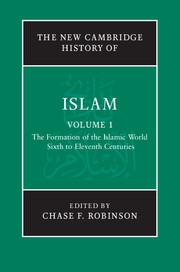Book contents
- Frontmatter
- Introduction
- PART I THE LATE ANTIQUE CONTEXT
- 1 The resources of Late Antiquity
- 2 The late Roman/early Byzantine Near East
- 3 The late Sasanian Near East
- 4 Pre-Islamic Arabia
- PART II UNIVERSALISM AND IMPERIALISM
- PART III REGIONALISM
- PART IV THE HISTORIOGRAPHY OF EARLY ISLAMIC HISTORY
- Conclusion: From formative Islam to classical Islam
- Glossary
- Bibliography
- Index
- Plate Section
- References
2 - The late Roman/early Byzantine Near East
from PART I - THE LATE ANTIQUE CONTEXT
Published online by Cambridge University Press: 28 March 2011
- Frontmatter
- Introduction
- PART I THE LATE ANTIQUE CONTEXT
- 1 The resources of Late Antiquity
- 2 The late Roman/early Byzantine Near East
- 3 The late Sasanian Near East
- 4 Pre-Islamic Arabia
- PART II UNIVERSALISM AND IMPERIALISM
- PART III REGIONALISM
- PART IV THE HISTORIOGRAPHY OF EARLY ISLAMIC HISTORY
- Conclusion: From formative Islam to classical Islam
- Glossary
- Bibliography
- Index
- Plate Section
- References
Summary
Rome was not ‘declining’ in Late Antiquity. In many ways it was thriving. Half a century of research – above all, archaeology – has shown in the Roman Near East a wealthy, well-populated world, whose inhabitants enjoyed a thriving economy and spent their money on lavish building projects, on silver and on high-quality textiles. In many areas of the Near East the Late Roman period, in terms of population size, settlement density and levels of exploitation, marks a pre-modern high. On the other hand, there is no doubt that between the third and sixth centuries the Roman empire was transformed in ways that do much to explain what happened in the seventh century. The key to this process was conflict with Sasanian Iran. In response to that threat the structure, organisation and culture of the empire was reshaped; Rome’s relations with the wider world were transformed; and the empire became involved in an escalating cycle of warfare that would culminate in the crisis out of which the Islamic world would emerge.
An obvious parallel is with the way the modern world is a product of the First World War. Without it we would have had neither Soviet Russia, nor Nazi Germany, nor the European Community, nor the United Nations, nor the current multi-state Middle East. That is not to say that peace in 1914 would have kept the world safe for imperialism and reaction, but that the war and its aftermath set the world on paths that would have been hardly imaginable six years earlier. In turn, the First World War can only be fully comprehended in the light of the European state system as it had evolved since the seventeenth century, a process that had divided the continent between powers equipped
Keywords
- Type
- Chapter
- Information
- The New Cambridge History of Islam , pp. 72 - 97Publisher: Cambridge University PressPrint publication year: 2010
References
- 4
- Cited by

